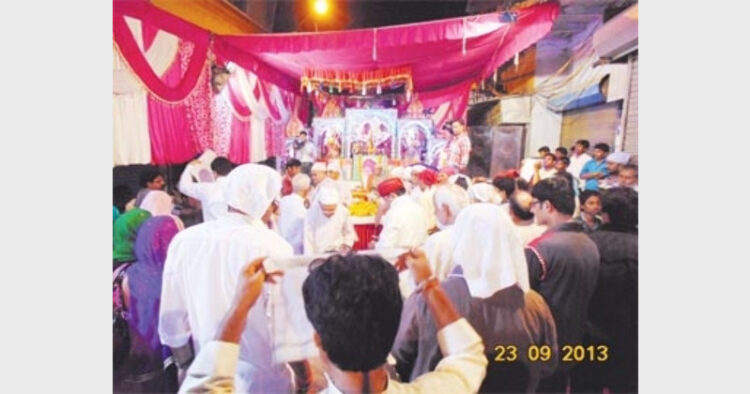 Once, Bhagwati Jagrans used to rule the roost in Delhi and other parts of India. Post economic liberalisation, these night long religious/musical discourses have started facing tough time to
Once, Bhagwati Jagrans used to rule the roost in Delhi and other parts of India. Post economic liberalisation, these night long religious/musical discourses have started facing tough time to
survive
Vivek Shukla
And it can safely be said that the era of Bhagwati Jagrans or Jagratas is coming to an end. The night long musical extravaganzas used to be the integral part of both Navratras, both Chet and Shardiye, in the Hindi heartland. And Delhi was their bastion. While Bhagwati Jagrans was promoted by the Punjabis, it was well accepted even in Bihar, Uttar Pradesh, Madhya Pradesh and Jharkhand. While night long religious discourse with
bhajans in praise of Durga used to rule the roost during Navratras, they were held all over the year though. And the best and most noticeable thing about them was that they were always ‘Vishal’. If there is a Bhagwati Jagrans, it has to be big. No place for modesty. Posters announcing the forthcoming Bhagwati Jagrans always mentioned without fail ‘Vishal Bhagwati Jagran’. Posters also used to carry the names of Jagran parties and long list of all those who organised them.
But, it seems that the era of Bhagwati Jagrans are all but over. It is Navratra time and you would hardly see any posters in your area about next Bhagwati Jagran. Till couple of years ago, important walls of the national
capital were full of such Bhagwati Jagran posters.
Well, the space vacated by Bhagwati Jagrans has been grabbed by Mata ki Chowki (MKC) and Sai Sandhya (SS). MKC is a mini edition of Bhagwati Jagrans. It starts at around 7 pm and everything is finished by 10 pm. And then the host offers mouth-watering
dinner to all those who attend MKC. Like MKC, the timing of SS is also same. It also concludes well before 10pm. While singers sing Bhentas praising Bhagwati in MKC, SS is all about Sai. There singers sing bhajans on Sai baba. So in both MKC and SS,
devotees do not have to wake-up full night. However, one thing is common. Singers of both MKC and SS are the same.
But, what are reasons for the sharp decline of interest for Bhagwati Jagrans? There has to be some factors that proved death-knell for Bhagwati Jagrans. After all, Bhagwati Jagrans were sweeping the religious scene for over five decades in Delhi, Punjab, Haryana and NCR. If you look back the rise and fall of Bhagwati Jagrans, you would notice that this was the gift to the nation by Punjabi community of Delhi. They mostly came from across the
border post partition of the country in 1947. Surprisngly, Punjabis of Punjab have not done any great service to make Bhagwati Jagrans such a rage.
Bhagwati Jagrans gradually started grabbing the religious space of Delhi in 60s. And the craze for it spread like some virus in various parts of the
country too. And it became a rage in 70s to mid 90s. The likes of Gulshan Kumar of T-Series fame have done yeoman service for the cause of Bhagwati Jagrans. Himself a devotee of Bhagwati, he used to release Bhagwati Jagran albums on regular basis. The likes of Narendra Chanchal, Anuradha Podwal, Sonu Nigam used to sing bhentas in albums released by T-series. Those were the salad days for Bhagwati Jagrans.
Honestly, no auspicious function in a family used to be considered complete without organising Bhagwati Jagran. Those were the days when Akhand Ramayana or Sunder Kaands hardly matched the might of Bhagwati Jagrans. Even families from Uttar Pradesh
prefered organising Bhagwati Jagran than Akhand Ramayana Paath or Sunder Kaand.
And Bollywood too smartly used Jagran songs in films like Suhaag and Aasha to exploit the religious
sensibilities of huge section of the
society. Remember super hits songs like, ‘Sabse Bada Tera Naam O Sheronwali …’ to Mohammad Rafi sung ‘Tune Mujhe Bulaya Sheranwaliye …’. And not to forget the song from one of the last hits of Rajesh Khanna Avatar, ‘Chalo Bulava Aaya Hai…’ Surely, these songs became the signature songs of every Bhagwati Jagran.
Post economic liberation in 1991, nature of jobs had seen paradigm shift. Regular 10 am to 5 pm jobs have started shrinking in a big way. Whole new
generations of young India have started emerging. They were to do night and odd jobs in fields like IT, Telecom and media. Life became more complicated and
challenging. Moreover, covering long distances to reach offices proved too much for young India. For them, it was not possible to attend night-long Bhagwati Jagran and then rush to the office in the morning. As that was not enough, these young Indians were not ready to take loot in the name of ‘Ardaas’ and poorly sung bhajans with third rate poetry and ear-shattering music.
So, DJs have lost the battle after being the monarch for decades. While the young India is God fearing and religious, it is not keen to be part of Bhagwati Jagran bandwagon. You go to any religious place, you would easily find large number of young devotees performing puja and other rituals. According to a recent survey conducted by Shaeed Bhagat Singh Seva Dal, a social welfare organisation in capital, God continued to be important to India’s youth, with 58 per cent of the respondents claiming they pray regularly.The percentage was higher among the female respondents, with 66 per cent of them saying they believe in the power of prayer.
In nutshell, you can say, Bhagwati Jagrans are vanishing very fast though MKC is still there. It also proves a point that religious preferences too change with the passage of time. Bhagwati Jagrans enjoyed the limelight for rather long period of time. Should we say good bye to them?
(The writer is former Editor, Somaiya Publications)













Comments